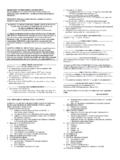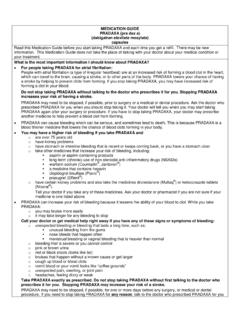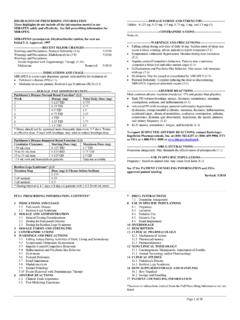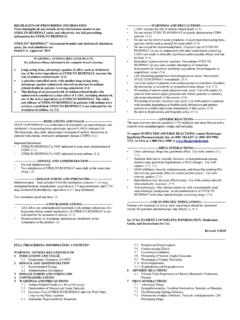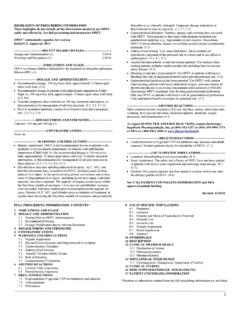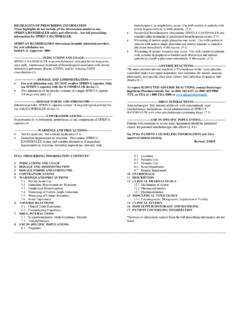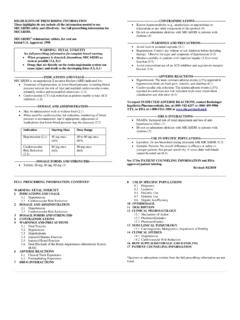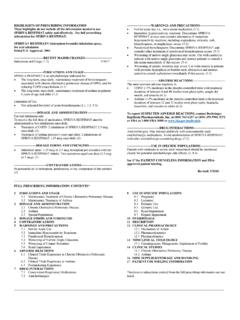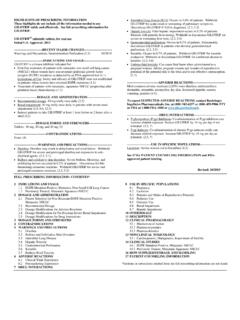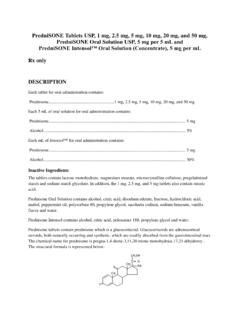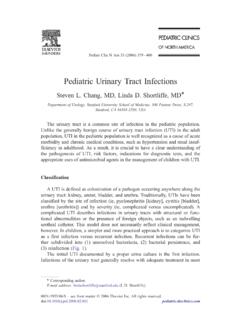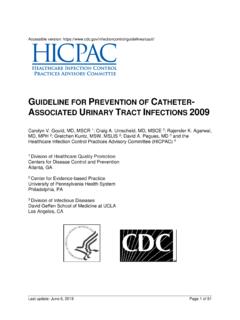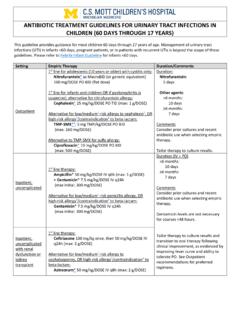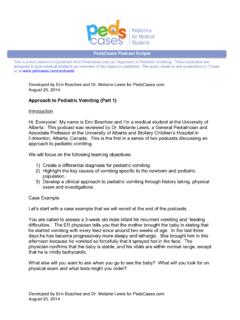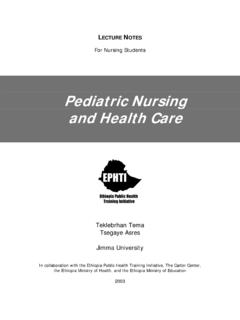Transcription of HIGHLIGHTS OF PRESCRIBING INFORMATION Before initiating ...
1 1 HIGHLIGHTS OF PRESCRIBING INFORMATION These HIGHLIGHTS do not include all the INFORMATION needed to use JARDIANCE safely and effectively. See full PRESCRIBING INFORMATION for JARDIANCE. JARDIANCE (empagliflozin) tablets, for oral use Initial Approval: 2014 ---------------------------RECENT MAJOR CHANGES--------------------------- Contraindications (4) 12/2017 Warnings and Precautions (5) 10/2018 ----------------------------INDICATIONS AND USAGE--------------------------- JARDIANCE is a sodium-glucose co-transporter 2 (SGLT2) inhibitor indicated: as an adjunct to diet and exercise to improve glycemic control in adults with type 2 diabetes mellitus, to reduce the risk of cardiovascular death in adult patients with type 2 diabetes mellitus and established cardiovascular disease.
2 (1) Limitations of Use: Not for the treatment of type 1 diabetes mellitus or diabetic ketoacidosis (1) ----------------------DOSAGE AND ADMINISTRATION----------------------- The recommended dose of JARDIANCE is 10 mg once daily, taken in the morning, with or without food ( ) Dose may be increased to 25 mg once daily ( ) Assess renal function Before initiating JARDIANCE. Do not initiate JARDIANCE if eGFR is below 45 mL/ m2 ( ) Discontinue JARDIANCE if eGFR falls persistently below 45 mL/ m2 ( ) ---------------------DOSAGE FORMS AND STRENGTHS---------------------- Tablets: 10 mg, 25 mg (3) -------------------------------CONTRAIND ICATIONS------------------------------ History of serious hypersensitivity reaction to empagliflozin or any of the excipients in JARDIANCE (4) Severe renal impairment, end-stage renal disease, or dialysis (4) -----------------------WARNINGS AND PRECAUTIONS------------------------ Hypotension.
3 Before initiating JARDIANCE assess and correct volume status in patients with renal impairment, the elderly, in patients with low systolic blood pressure, and in patients on diuretics. Monitor for signs and symptoms during therapy. ( ) Ketoacidosis: Assess patients who present with signs and symptoms of metabolic acidosis for ketoacidosis, regardless of blood glucose level. If suspected, discontinue JARDIANCE, evaluate and treat promptly. Before initiating JARDIANCE, consider risk factors for ketoacidosis. Patients on JARDIANCE may require monitoring and temporary discontinuation of therapy in clinical situations known to predispose to ketoacidosis. ( ) Acute Kidney Injury and Impairment in Renal Function: Consider temporarily discontinuing in settings of reduced oral intake or fluid losses.
4 If acute kidney injury occurs, discontinue and promptly treat. Monitor renal function during therapy. ( ) Urosepsis and Pyelonephritis: Evaluate patients for signs and symptoms of urinary tract infections and treat promptly, if indicated ( ) Hypoglycemia: Consider lowering the dose of insulin secretagogue or insulin to reduce the risk of hypoglycemia when initiating JARDIANCE ( ) Necrotizing Fasciitis of the Perineum (Fournier s Gangrene): Serious, life-threatening cases have occurred in both females and males. Assess patients presenting with pain or tenderness, erythema, or swelling in the genital or perineal area, along with fever or malaise. If suspected, institute prompt treatment.
5 ( ) Genital Mycotic infections : Monitor and treat as appropriate ( ) Hypersensitivity Reactions: Discontinue JARDIANCE, treat promptly, and monitor until signs and symptoms resolve ( ) Increased LDL-C: Monitor and treat as appropriate ( ) ------------------------------ADVERSE REACTIONS------------------------------- The most common adverse reactions associated with JARDIANCE (5% or greater incidence) were urinary tract infections and female genital mycotic infections ( ) To report SUSPECTED ADVERSE REACTIONS, contact Boehringer Ingelheim Pharmaceuticals, Inc. at 1-800-542-6257 or 1-800-459-9906 TTY, or FDA at 1-800-FDA-1088 or -----------------------USE IN SPECIFIC POPULATIONS------------------------ Pregnancy: Advise females of the potential risk to a fetus especially during the second and third trimesters ( ) Lactation: JARDIANCE is not recommended when breastfeeding ( ) Geriatric Patients: Higher incidence of adverse reactions related to volume depletion and reduced renal function ( , , ) Patients with Renal Impairment: Higher incidence of adverse reactions related to reduced renal function ( , , ) See 17 for PATIENT COUNSELING INFORMATION and Medication Guide.
6 Revised: 10/2018_____ FULL PRESCRIBING INFORMATION : CONTENTS* 1 INDICATIONS AND USAGE 2 DOSAGE AND ADMINISTRATION Recommended Dosage Patients with Renal Impairment 3 DOSAGE FORMS AND STRENGTHS 4 CONTRAINDICATIONS 5 WARNINGS AND PRECAUTIONS Hypotension Ketoacidosis Acute Kidney Injury and Impairment in Renal Function Urosepsis and Pyelonephritis Hypoglycemia with Concomitant Use with Insulin and Insulin Secretagogues Necrotizing Fasciitis of the Perineum (Fournier s Gangrene) Genital Mycotic infections Hypersensitivity Reactions Increased Low-Density Lipoprotein Cholesterol (LDL-C) 6 ADVERSE REACTIONS Clinical Trials Experience Postmarketing Experience 7 DRUG INTERACTIONS Diuretics Insulin or Insulin Secretagogues Positive Urine Glucose Test Interference with 1,5-anhydroglucitol (1,5-AG)
7 Assay 8 USE IN SPECIFIC POPULATIONS Pregnancy Lactation Pediatric Use Geriatric Use Renal Impairment Hepatic Impairment 10 OVERDOSAGE 11 DESCRIPTION 12 CLINICAL PHARMACOLOGY Mechanism of Action Pharmacodynamics Pharmacokinetics 13 NONCLINICAL TOXICOLOGY Carcinogenesis, Mutagenesis, Impairment of Fertility 14 CLINICAL STUDIES Glycemic Control Cardiovascular Outcomes in Patients with Type 2 Diabetes Mellitus and Atherosclerotic Cardiovascular Disease 16 HOW SUPPLIED/STORAGE AND HANDLING 17 PATIENT COUNSELING INFORMATION *Sections or subsections omitted from the full PRESCRIBING INFORMATION are not listed. 2 FULL PRESCRIBING INFORMATION 1 INDICATIONS AND USAGE JARDIANCE is indicated: as an adjunct to diet and exercise to improve glycemic control in adults with type 2 diabetes mellitus, to reduce the risk of cardiovascular death in adult patients with type 2 diabetes mellitus and established cardiovascular disease.
8 Limitations of Use JARDIANCE is not recommended for patients with type 1 diabetes or for the treatment of diabetic ketoacidosis. 2 DOSAGE AND ADMINISTRATION Recommended Dosage The recommended dose of JARDIANCE is 10 mg once daily in the morning, taken with or without food. In patients tolerating JARDIANCE, the dose may be increased to 25 mg [see Clinical Studies (14)]. In patients with volume depletion, correcting this condition prior to initiation of JARDIANCE is recommended [see Warnings and Precautions ( ), Use in Specific Populations ( ) and Patient Counseling INFORMATION (17)]. Patients with Renal Impairment Assessment of renal function is recommended prior to initiation of JARDIANCE and periodically thereafter.
9 JARDIANCE should not be initiated in patients with an eGFR less than 45 mL/ m2. No dose adjustment is needed in patients with an eGFR greater than or equal to 45 mL/ m2. JARDIANCE should be discontinued if eGFR is persistently less than 45 mL/ m2 [see Warnings and Precautions ( , ) and Use in Specific Populations ( )]. 3 DOSAGE FORMS AND STRENGTHS JARDIANCE tablets available as: 10 mg pale yellow, round, biconvex and bevel-edged, film-coated tablets debossed with S 10 on one side and the Boehringer Ingelheim company symbol on the other side. 25 mg pale yellow, oval, biconvex, film-coated tablets debossed with S 25 on one side and the Boehringer Ingelheim company symbol on the other side.
10 4 CONTRAINDICATIONS History of serious hypersensitivity reaction to empagliflozin or any of the excipients in JARDIANCE [see Warnings and Precautions ( )]. Severe renal impairment, end-stage renal disease, or dialysis [see Use in Specific Populations ( )]. 5 WARNINGS AND PRECAUTIONS Hypotension JARDIANCE causes intravascular volume contraction. Symptomatic hypotension may occur after initiating JARDIANCE [see Adverse Reactions ( )] particularly in patients with renal impairment, the elderly, in patients with low systolic blood pressure, and in patients on diuretics. Before initiating JARDIANCE, assess 3 for volume contraction and correct volume status if indicated.
